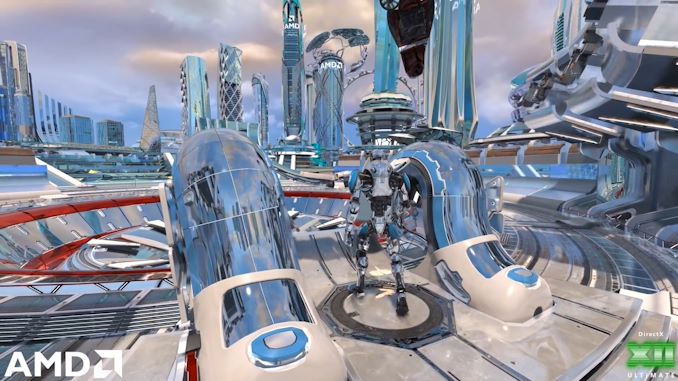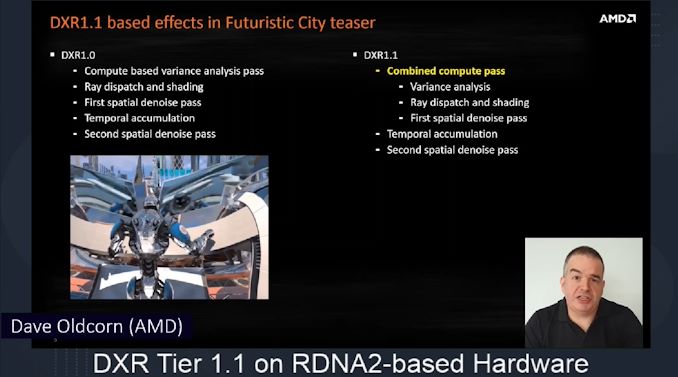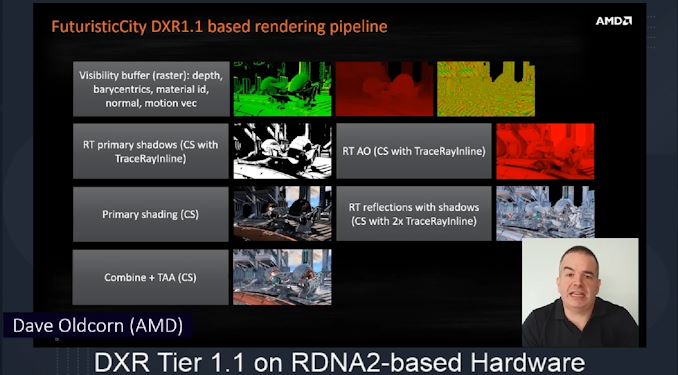Quick Note: AMD Shows Off Raytracing on RDNA2
by Ryan Smith on March 19, 2020 5:30 PM EST- Posted in
- GPUs
- AMD
- DirectX 12
- DirectX Raytracing
- RDNA2

With today’s announcement from Microsoft of DirectX 12 Ultimate, both NVIDIA and AMD are also chiming in to reiterate their support for the new feature set, and to note their involvement in the process. For AMD, DirectX 12 Ultimate goes hand-in-hand with their forthcoming RDNA2 architecture, which will be at the heart of the Xbox Series X console, and will be AMD’s first architecture to support DirectX 12 Ultimate’s new features, such as ray tracing and variable rate shading.
To that end, as part of Microsoft’s overall DirectX Developer Day presentation, AMD is showing off raytracing running on an RDNA2 for the first time in public. Running an AMD-built demo they call “Futuristic City”, the demo incorporates DXR 1.0 and 1.1 features, to produce what can only be described as a very shiny demo.
It should be noted that this demo was a recording – as all of the Microsoft dev day presentations were – though there is little reason to doubt its authenticity. AMD also showed off an RT recording a couple of weeks back for Financial Analyst day, and presumably this is the same trailer.
Source: AMD












100 Comments
View All Comments
Zizy - Friday, March 20, 2020 - link
For mirror reflection you simply have one ray as input, one fixed ray as output and you don't need many of them to get accurate visuals of the structure. Despite many bounces, number of rays remains manageable because you have one extra ray each time. Besides shiny look here, each ray probably bounced just few times on average (say 3x). On the other hand, something diffuse requires various tricks or tons of output rays to get something resembling correct visuals - each such surface requires hundreds of rays even if you want something as crude as sampling on 5 degrees. (that said, this is from my experience doing optical simulations, I never did RT in games)willis936 - Friday, March 20, 2020 - link
Walking a ray doesn’t seem very computationally intensive compared to, say, rendering another thousand pixels from a different perspective (ie an entire shiny surface).Sefem - Saturday, March 21, 2020 - link
Thread divergence caused by incoherent rays generated by rough surfaces thank GPU performanceD. Lister - Saturday, March 21, 2020 - link
"So which are the most computationally intensive features of ray-tracing?"Global illumination, with raytraced ambient occlusion and multiple intersecting dynamic light sources.
yeeeeman - Friday, March 20, 2020 - link
Yep, I also suspect their ray tracing hardware is a bit hit and miss for this first generation.Sefem - Saturday, March 21, 2020 - link
Exactly, and reflection in the AMD demo are half resolution too but I don't know how deep (reflection of a refection of a reflection...) they areThreska - Thursday, March 19, 2020 - link
The one time "Oh! Shiny." applies.Santoval - Thursday, March 19, 2020 - link
The demo has way too many mirrors and reflective surfaces. I wonder how it would look if the sky was not cloudy and it was high noon..mode_13h - Friday, March 20, 2020 - link
They do that just to show it's not faked and so you can see how many secondary-bounces they support. Another mark of quality to look for is aliasing in the reflections.Dribble - Friday, March 20, 2020 - link
They do that cause it's easy - they have very few different types of surface in that demo to model, and they are all super shiny which is the easiest to ray trace. That said you've got to start somewhere, but I hope they can do a lot more then that.